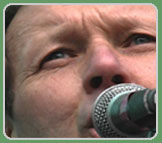 |
|
| Chapter 1: |
Father Roy Bourgeois |
 |
|
| Chapter 2: |
An act of conscience: Marie Dennis at SOA |
 |
|
| In order to view the video or the stills you need to have RealPlayer installed. |
|
|
By Public WebWorks Staff and wire reports
19 Nov 2000, Columbus, Ga. -- Despite a steady rain and frigid temperatures, more
than 5,000 protesters chanted, prayed and stomped in the mud around Ft.
Benning Nov. 19 with a common demand: close the U.S. Army School of the
Americas.
It was the tenth year for this annual protest. By its end, 1,700
people, including actor Martin Sheen, were arrested by military
officials and received letters banning them from the post for five
years.
At the head of the procession were people dressed in shrouds, wearing
white masks and carrying coffins representing Latin Americans they say
had been killed by people trained at the school. When the protesters
were nearly a half mile into the post, they set the coffins down, poured
red paint on themselves and fell to the ground in what they called a
"die in."
When they refused to get on buses, they were put into plastic
handcuffs, photographed and placed on canvas litters to be processed.
The protests were led by the Father Roy Bourgeois, a Vietnam veteran who
says he is committed to non-violent tactics. Military officials said
that less than one percent of the students have been linked to any
violence. School of the Americas Watch
Bourgeois paid special tribute to protestors who joined the School of
the America's action from campaigns against the World Bank and
sweatshops. Many of those involved also participated in protests
against the World Trade Organization an the International Monetary Fund.
For the most part, however, the School of the America's movement is
faith based, including many Catholic nuns.
"I think of this as kind of prayer. By our very presence we are
standing for what we believe in," said Sister John Backenstos of the
Holy Names of Jesus and Mary order of McKenzie Bridge, Ore.
In 1999, about 65 people were cited when they entered the post. But
this year post commander Maj. Gen. John Le Moyne decided to cite more
people because it gives "us an opportunity to engage in a dialogue about
the school," Le Moyne said. Fort Benning, Georgia Home of the Infantry USAIC USAIS ARMY Ranger Airborne
Le Moyne said that instructors and chaplains at the school talked with
protesters about the school's philosophy and curriculum.
The school's commander, Col. Glen Weidner, conceded that the protests
have had an impact. The school is scheduled to close next month and
reopen in January with a new name, the Western Hemisphere Institute for
Security Cooperation. The school plans to feature more human rights
courses and an oversight committee.
Bourgeois said renaming the school was the same as relabeling a bottle
of poison with the word "penicillin. It's still deadly."
Hundreds of protesters carried crosses bearing the names of people who
they say died at the hands of the military in Mexico and Central and
South America. Before boarding the buses to be processed they planted
the crosses into the wet ground.
Sheen and others in the front knelt on the pavement, waiting for the
military police. When they didn't come, he said, "Let's go to Muhammad"
and walked to the waiting buses along with the others. People carrying
crosses were asked by police to leave them. Many protesters forced the
crosses into the ground before boarding buses.
The protests coincide with the Nov. 16, 1989, murder of six Jesuit
priests, their housekeeper and her 15-year-old daughter. A United
Nations truth commission found that 19 of the 26 soldiers implicated in
the deaths were SOA graduates.
Alisa Daubenspeck, a senior at Oberlin College in Ohio, said it was
important for her to be at Sunday's protest because "we elect the people
that fund this school."
|